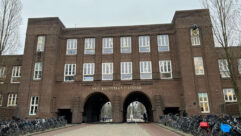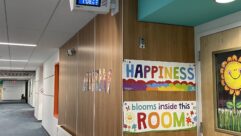
The Buzz: Installation Spotlight: Detroit School of Arts
Mar 1, 2008 12:00 PM,
By Trevor Boyer
Accelerated AV

In an abbreviated time frame, Communication Design Associates designed and installed the Detroit School of Arts’ $22.5-million AV system, which included systems for the building’s professional radio station and the school’s television and radio studios and some of its classrooms.
For Communication Design Associates (CDA) of Canton, Mass., the design for the Detroit School of Arts’ $22.5-million AV system was an extremely complicated affair, and one that had to happen quickly. The magnet high school in the city’s culturally rich Midtown district was phasing in a new sophisticated media arts program as its brand-new building opened, but students in the building weren’t going to have its facilities all to themselves — it was also designed to house a professional radio station.
Detroit Public Schools had previously owned a radio station that was losing money for the already cash-strapped district. The district put the management of what had been WDTR out for bid, and Detroit Public Television, the local PBS affiliate, won the contract and restarted the station as WCRJ, with a classical/jazz format. This transition was happening just as CDA was becoming involved in the AV design for the building, which put the firm in the awkward position of designing a radio station infrastructure before a user had been identified.
“Based on all my years of experience in the broadcast industry, I designed this radio station around not knowing what format they were going to be,” says Greg Vincent, a principal consultant at CDA. “I just gave them everything I could possibly think of that would be required within a station. Luckily we came really close.”
(The new WCRJ station incorporates content from NPR, PRI, and other syndicated content sources, requiring CDA to specify multiple satellite dishes for the project.)
The technology program for the school and radio station originally launched in 1998, under a different set of consultants, but the project was put on hold for a while. Then, in 2002, one of the project’s subcontractors approached CDA and hired the firm to design a conduit system for the seven-story, 325,000-square-foot building — all within six weeks.
Then, the school district’s project-management team also hired CDA directly to design the AV systems for the radio station’s rooms, the school’s television and radio studios, and some of its classrooms — more than 30 rooms. After a few more delays, CDA began designing the audiovisual systems in 2004. By that point, the design had to happen within a year so that the installation could begin on time.
“We actually output [AV system designs for] both radio and TV the AV systems in nine months, with radio being done in about five months,” says Stewart Randall, another principal at CDA.
The goal for CDA was to create a professional radio studio and a top-notch educational facility for students that would mirror the professional side. Eventually, the broadcast students at the School of Arts will be allowed to produce content for WRCJ and run their own Internet radio station.
There was also the student TV studio and the IT backbone for the entire building to consider. CDA chose Apple storage in the form of Xserve RAID boxes, adding up to 150TB — a storage integration job handled by Mac Professional. This was one of the largest X-RAID installations at an educational institution in the nation at that time, according to Apple officials. This massive server allows each student at the school to save four years of work in centralized storage, whether they are working on a 2006-vintage Mac Pro or one of the school’s many Windows machines.
The WRCJ radio side includes an on-air control room, an on-air news control room, a call screener/producer room, a production control room, and a studio. The student side consists of identical on-air control and production control rooms, each with attached voiceover/interview booths. For these rooms, CDA specified RE20 microphones from Electro-Voice, Marantz CDR510 CD-R/RW and CD players and PMD570 digital audio recorders, and Tannoy Reveal near-field monitors.
Four Sharp LC-45GD6U 45in. LCD monitors in the school’s and the station’s on-air control and production control rooms display feeds from rehearsal halls and the school’s TV studio and auditorium.
“They can talk to those rooms, as well,” Randall says. “There’s a building-wide [Telex] RTS ADAM intercom system, which actually will hook up to Detroit Public Television, so they’ll be able to communicate with master control of DPTV.”
The school and WRCJ share the building’s 10 audio editing rooms. Each room includes a Digidesign Pro Tools LE system, a Wheatstone Generation 3 digital console, and a pair of Bag End M-6 loudspeakers for monitoring — loudspeakers chosen for their accuracy and small size.
During the installation phase of the project, Randall says he racked up 250,000 frequent-flyer miles traveling to weekly construction meetings. “Despite the fact that this was a $20-million project, our error and omission rate was less than 1 percent,” he says. “That’s for a design that required three 300-page volumes of specifications.”
SUBSCRIBE TO SOUND & VIDEO CONTRACTOR E-NEWSLETTERS!
- Sound & Video Contractor EXTRA
Systems Integration Special Focus series:
- Houses of Worship
- Corporate AV
- Residential AV
- AV Over Fiber
- AV in Education
Breaking industry news in your email inbox every other week!
Subscribe atwww.svconline.com










